-
question_answer1)
Which of the following best describes the given triangle.

A)
Isosceles acute triangle done
clear
B)
Isosceles right triangle done
clear
C)
Equilateral obtuse triangle done
clear
D)
Isosceles obtuse triangle done
clear
View Solution play_arrow
-
question_answer2)
Which of the following statement is true about the given figure?

A)
It is an octagon. done
clear
B)
It is a regular polygon. done
clear
C)
It is a polygon. done
clear
D)
It is a quadrilateral. done
clear
View Solution play_arrow
-
question_answer3)
A quadrilateral is a rhombus but not a square if
A)
its diagonals do not bisect each other done
clear
B)
its diagonals are not perpendicular done
clear
C)
opposite angles are not equal done
clear
D)
the length of diagonals are not equal done
clear
View Solution play_arrow
-
question_answer4)
In which of the following figures the adjacent sides are not necessarily be equal?
A)
Parallelogram done
clear
B)
Rhombus done
clear
C)
Rectangle done
clear
D)
Square done
clear
View Solution play_arrow
-
question_answer5)
If a quadrilateral with two pairs of adjacent sides equal but opposite sides are not equal then it is called
A)
parallelogram done
clear
B)
square done
clear
C)
rectangle done
clear
D)
kite done
clear
View Solution play_arrow
-
question_answer6)
If two adjacent angles of a parallelogram are in the ratio 3 : 2, then the measure of the angles are
A)
\[108{}^\circ \],\[72{}^\circ \] done
clear
B)
\[72{}^\circ \], \[36{}^\circ \] done
clear
C)
\[100{}^\circ \], \[80{}^\circ \] done
clear
D)
\[144{}^\circ \], \[36{}^\circ \] done
clear
View Solution play_arrow
-
question_answer7)
The sum of angles of a quadrilateral is
A)
\[180{}^\circ \] done
clear
B)
\[360{}^\circ \] done
clear
C)
\[270{}^\circ \] done
clear
D)
none of these done
clear
View Solution play_arrow
-
question_answer8)
Number of lines passing through five points such that no three of them are collinear is
A)
10 done
clear
B)
5 done
clear
C)
20 done
clear
D)
8 done
clear
View Solution play_arrow
-
question_answer9)
Number of line segments in Fig. is

A)
5 done
clear
B)
10 done
clear
C)
15 done
clear
D)
20 done
clear
View Solution play_arrow
-
question_answer10)
In Fig. \[-D\,XYZ\] cannot be written as

A)
\[\angle \,Y\] done
clear
B)
\[\angle \,ZXY\] done
clear
C)
\[\angle \,ZYX\] done
clear
D)
\[\angle \,XYP\] done
clear
View Solution play_arrow
-
question_answer11)
The number of angles in Fig. is

A)
3 done
clear
B)
4 done
clear
C)
5 done
clear
D)
6 done
clear
View Solution play_arrow
-
question_answer12)
The number of obtuse angles is

A)
2 done
clear
B)
3 done
clear
C)
4 done
clear
D)
5 done
clear
View Solution play_arrow
-
question_answer13)
In Fig. AB = BC and AD = BD = DC. The number of isosceles triangles in the figure is

A)
1 done
clear
B)
2 done
clear
C)
3 done
clear
D)
4 done
clear
View Solution play_arrow
-
question_answer14)
In Fig. \[PQ\bot RQ,\,\,PQ=5\,cm\] and \[QR=5\,cm\]. Then \[\Delta \,PQR\] is

A)
a right triangle but not isosceles done
clear
B)
an isosceles right triangle done
clear
C)
isosceles but not a right triangle done
clear
D)
neither isosceles nor right triangle done
clear
View Solution play_arrow
-
question_answer15)
How many complete turns is equivalent to\[90{}^\circ \]?
A)
2 done
clear
B)
1 done
clear
C)
\[\frac{1}{2}\] done
clear
D)
\[\frac{1}{4}\] done
clear
View Solution play_arrow
-
question_answer16)
Which of the following is an obtuse angle?
A)
\[30{}^\circ \] done
clear
B)
\[60{}^\circ \] done
clear
C)
\[87{}^\circ \] done
clear
D)
\[123{}^\circ \] done
clear
View Solution play_arrow
-
question_answer17)

Find the value of angle y in the above figure.
A)
\[26{}^\circ \] done
clear
B)
\[39{}^\circ \] done
clear
C)
\[47{}^\circ \] done
clear
D)
\[53{}^\circ \] done
clear
View Solution play_arrow
-
question_answer18)
In the adjoining figure line L || line M and line N is the transversal. Which of the following line is one of the pairs of alternative angles ?

A)
\[\angle a\,\And \angle e\] done
clear
B)
\[\angle d\,\And \angle f\] done
clear
C)
\[\angle b\,\,\text{and}\,\angle f\] done
clear
D)
\[\angle d\,\,\text{and}\,\angle e\] done
clear
View Solution play_arrow
-
question_answer19)
If the measure of each angle of a regular polygon is \[60{}^\circ \], what is the name of the polygon?
A)
Quadrilateral done
clear
B)
Hexagon done
clear
C)
Pentagon done
clear
D)
Triangle done
clear
View Solution play_arrow
-
question_answer20)
In the adjoining figure, AB || CD. Find the alternate angle to \[\angle BAC\]

A)
\[\angle BAC\] done
clear
B)
\[\angle ACD\] done
clear
C)
\[\angle BCD\] done
clear
D)
\[\angle DCE\] done
clear
View Solution play_arrow
-
question_answer21)
Which of the following measures can't be measures of three sides of a right angled triangle?
A)
15, 20 and 25 done
clear
B)
15, 112 and 113 done
clear
C)
9, 40 and 41 done
clear
D)
7, 25 and 26 done
clear
View Solution play_arrow
-
question_answer22)
The measure of an angle is \[\frac{4}{5}\] times its supplement. Find the angle.
A)
\[100{}^\circ \] done
clear
B)
\[80{}^\circ \] done
clear
C)
\[110{}^\circ \] done
clear
D)
\[70{}^\circ \] done
clear
View Solution play_arrow
-
question_answer23)
Find the value of \[\angle a-\angle b\] in the adjoining figure.

A)
\[50{}^\circ \] done
clear
B)
\[70{}^\circ \] done
clear
C)
\[10{}^\circ \] done
clear
D)
\[60{}^\circ \] done
clear
View Solution play_arrow
-
question_answer24)
Which of the following is not helpful in practical Geometry?
A)
Set squares done
clear
B)
Protractor done
clear
C)
The compasses done
clear
D)
Scissor done
clear
View Solution play_arrow
-
question_answer25)
How many lines can be drawn which are perpendicular to a given line and pass through a point lying on the line?
A)
one done
clear
B)
two done
clear
C)
three done
clear
D)
infinitely many done
clear
View Solution play_arrow
-
question_answer26)
A scalene triangle can ____ be a right triangle.
A)
always done
clear
B)
never done
clear
C)
sometimes done
clear
D)
not be determined done
clear
View Solution play_arrow
-
question_answer27)
Parallel lines are____ intersecting lines.
A)
always done
clear
B)
never done
clear
C)
sometimes done
clear
D)
two done
clear
View Solution play_arrow
-
question_answer28)
vertical angles are ____ right angles.
A)
always done
clear
B)
never done
clear
C)
sometimes done
clear
D)
cannot say done
clear
View Solution play_arrow
-
question_answer29)
A regular octagon has ____ lines of symmetry.
A)
8 done
clear
B)
4 done
clear
C)
2 done
clear
D)
0 done
clear
View Solution play_arrow
-
question_answer30)
A square has____ lines of symmetry.
A)
4 done
clear
B)
8 done
clear
C)
2 done
clear
D)
0 done
clear
View Solution play_arrow
-
question_answer31)
An isosceles triangle has ____ line of symmetry.
A)
8 done
clear
B)
4 done
clear
C)
2 done
clear
D)
1 done
clear
View Solution play_arrow
-
question_answer32)
A parallelogram has ____ line of symmetry
A)
8 done
clear
B)
4 done
clear
C)
2 done
clear
D)
0 done
clear
View Solution play_arrow
-
question_answer33)
A cuboid looks like a ____ box.
A)
square done
clear
B)
cubical done
clear
C)
rectangular done
clear
D)
triangular done
clear
View Solution play_arrow
-
question_answer34)
A triangular pyramid is known as a ___.
A)
tetrahedron done
clear
B)
cuboid done
clear
C)
cube done
clear
D)
prism done
clear
View Solution play_arrow
-
question_answer35)
A square pyramid has a ____ as its base.
A)
triangle done
clear
B)
rectangle done
clear
C)
square done
clear
D)
pyramid done
clear
View Solution play_arrow
-
question_answer36)
A triangular prism looks like the shape of a
A)
triangle done
clear
B)
Kaleidoscope done
clear
C)
tetrahedron done
clear
D)
cone done
clear
View Solution play_arrow
-
question_answer37)
Read the figure carefully and answer the questions that follows.

\[\Delta ABC\] is a ____
A)
right angled triangle done
clear
B)
equilateral triangle done
clear
C)
isosceles triangle done
clear
D)
scalene triangle done
clear
View Solution play_arrow
-
question_answer38)
Read the figure carefully and answer the questions that follows.

Which of the following is an isosceles triangle?
A)
\[\Delta ALD\] done
clear
B)
\[\Delta ADC\] done
clear
C)
\[\Delta AEB\] done
clear
D)
None of these done
clear
View Solution play_arrow
-
question_answer39)
Read the figure carefully and answer the questions that follows.

\[\Delta ABL\] and \[\Delta \,ALC\] are ____
A)
right angled triangles done
clear
B)
equilateral triangles done
clear
C)
isosceles triangles done
clear
D)
scalene triangles done
clear
View Solution play_arrow
-
question_answer40)
A quadrilateral in which both pairs of opposite sides are parallel is a...........
A)
square done
clear
B)
rhombus done
clear
C)
rectangle done
clear
D)
parallelogram done
clear
View Solution play_arrow
-
question_answer41)
A quadrilateral in which diagonals are equal and bisect each other perpendicularly is a...........
A)
square done
clear
B)
rhombus which is not a square done
clear
C)
rectangle which is not a square done
clear
D)
None of these done
clear
View Solution play_arrow
-
question_answer42)
The triangular shaped instruments in the geometrical box are called ________.
A)
protractor done
clear
B)
Divider done
clear
C)
Compass done
clear
D)
Set squares done
clear
View Solution play_arrow
-
question_answer43)
The semi-circular shaped instrument (in the geometrical box) is called ________.
A)
Protractor done
clear
B)
Divider done
clear
C)
Compass done
clear
D)
Set ? squares done
clear
View Solution play_arrow
-
question_answer44)
In a protractor, the mid-point of 0-180 line is called the ______ of the protractor.
A)
centre done
clear
B)
radius done
clear
C)
chord done
clear
D)
bisector done
clear
View Solution play_arrow
-
question_answer45)
DIRECTIONS: Match Column-I with Column-II and select the correct answer using the codes given below the columns.

A)
\[A\to (i),\,B\to (iv);\,C\to (ii);\,D\to (iii)\] done
clear
B)
\[A\to (iv),\,B\to (ii);\,C\to (i);\,D\to (iii)\] done
clear
C)
\[A\to (iv),\,B\to (i);\,C\to (ii);\,D\to (iii)\] done
clear
D)
\[A\to (i),\,B\to (iv);\,C\to (iii);\,D\to (ii)\] done
clear
View Solution play_arrow
-
question_answer46)
DIRECTIONS: Match Column-I with Column-II and select the correct answer using the codes given below the columns.

A)
\[A\to (iii),\,B\to (i);\,C\to (iv);\,D\to (ii)\] done
clear
B)
\[A\to (i),\,B\to (iii);\,C\to (ii);\,D\to (iv)\] done
clear
C)
\[A\to (iii),\,B\to (iv);\,C\to (ii);\,D\to (i)\] done
clear
D)
\[A\to (i),\,B\to (ii);\,C\to (iv);\,D\to (iii)\] done
clear
View Solution play_arrow
-
question_answer47)
DIRECTIONS: Match Column-I with Column-II and select the correct answer using the codes given below the columns.

A)
\[A\to (iii),\,B\to (v);\,C\to (iv);\,D\to (i);\,E\to (vi);\,F\to (ii)\] done
clear
B)
\[A\to (iv),\,B\to (v);\,C\to (vi);\,D\to (i);\,E\to (ii);\,F\to (iii)\] done
clear
C)
\[A\to (iv),\,B\to (ii);\,C\to (iii);\,D\to (i);\,E\to (v);\,F\to (vi)\] done
clear
D)
\[A\to (iii),\,B\to (iv);\,C\to (v);\,D\to (vi);\,E\to (i);\,F\to (ii)\] done
clear
View Solution play_arrow
-
question_answer48)
DIRECTIONS: Passage-1 Read the passage(s) given below and answer the questions that follow. Complete the passage given below by choosing the correct option. A regular polygon has all sides and all angles equal. Polygons with eight sides are called __(i)__. Hexagons are polygons with __(ii)__ sides and angles. Five sided polygons are called __(iii)__. They have five angles. Polygons with seven sides are called __(iv)__.
A)
(i) \[\to \] octagon; (ii) \[\to \] six; (iii) \[\to \] Pentagon; (iv) \[\to \] Heptagon done
clear
B)
(i) \[\to \] Heptagon; (ii) \[\to \] six; (iii) \[\to \] Octagon; (iv) \[\to \] Pentagon done
clear
C)
(i) \[\to \] Heptagon; (ii) \[\to \] six; (iii) \[\to \] Pentagon; (iv) \[\to \] octagon done
clear
D)
(i) \[\to \] Heptagon; (ii) \[\to \] octagon; (iii) \[\to \] seven; (iv) \[\to \] Pentagon done
clear
View Solution play_arrow
-
question_answer49)
DIRECTIONS: Passage-2 Read the passage(s) given below and answer the questions that follow. \[\underset{\text{(i)}}{\mathop{\underline{\text{A}\,\text{prism}}}}\,\] is a solid whose \[\underset{\text{(ii)}}{\mathop{\underline{\text{vertcies}}}}\,\] is a polygon such as a \[\underset{\text{(iii)}}{\mathop{\underline{\text{triangle}}}}\,\] or a square. Its side faces are \[\underset{\text{(iv)}}{\mathop{\underline{\text{squares}}}}\,\] that have a common \[\underset{\text{(v)}}{\mathop{\underline{\text{sides}}}}\,\]. A pyramid is named according to the shape of its \[\underset{\text{(vi)}}{\mathop{\underline{\text{length}}}}\,\] A \[\underset{\text{(vii)}}{\mathop{\underline{\text{rectangular}}}}\,\] pyramid has four faces, six \[\underset{\text{(viii)}}{\mathop{\underline{\text{vertices}}}}\,\] and four \[\underset{\text{(ix)}}{\mathop{\underline{\text{edges}}}}\,\]. Choose the correct option to correct the underline words.
A)
(i)Prism (ii) base (iii) square (iv) triangles (v) base (vi) edges (vii) rectangular (viii) vertices (ix) vertex done
clear
B)
(i) Pyramid (ii) base (iii) rectangle (iv) triangles (v) vertex (vi) base (vii) triangular (viii) edges (ix) vertices done
clear
C)
(i) cone (ii) length (iii) square (iv) cylinder (v) edges (vi) base (vii) triangular (viii) edges (ix) vertices done
clear
D)
(i) cylinder (ii) base (iii) triangle (iv) vertex (v) base (vi) edges (vii) triangular (viii) vertices (ix) rectangle done
clear
View Solution play_arrow
-
question_answer50)
DIRECTIONS: Passage-3 Read the passage(s) given below and answer the questions that follow. Refer to the given figure and complete the paragraph by choosing correct option.
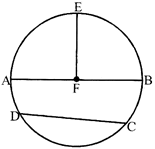
__(i)__ is the diameter of the circle. CD is a __(ii)__ of the circle. If the length of BF is 4 cm, then the length of AB will be __(iii)__. DAEBC is the __(iv)__ segment of the circle. Arc DCE is a major arc of the circle. Its corresponding minor arc is __(v)__.
A)
(i) EF; (ii) Radius; (iii) 16 cm; (iv) major; (v) DA done
clear
B)
(i) AB; (ii) Radius; (iii) 8 cm; (vi) minor; (v) DE done
clear
C)
(i) EF; (ii) Chord; (iii) 4 cm; (vi) major; (v) DAE done
clear
D)
(i) AB; (ii) Chord; (iii) 8 cm; (vi) major; (v) DAE done
clear
View Solution play_arrow
-
question_answer51)
Read the following statements and choose the best answer. (i) A square can be thought of as a special rectangle. (ii) A rectangle with all sides equal becomes a square.
A)
(i) and (ii) are true and (ii) is correct explanation for (i). done
clear
B)
(i) is true and (ii) is false. done
clear
C)
(i) is false and (ii) is true. done
clear
D)
(i) and (ii) are true but (ii) is not true explanation for (i). done
clear
View Solution play_arrow
-
question_answer52)
Read the given statement and choose the correct reasoning for the statement. "squares, rectangles, parallelograms are all quadrilaterals".
A)
All these are irregular shapes. done
clear
B)
All these have angles which are equal in measure. done
clear
C)
All these are four sided polygons made of line segments. done
clear
D)
All these are closed figures. done
clear
View Solution play_arrow
-
question_answer53)
Which of the following has a greater measure? (i) an angle complementary to\[15{}^\circ \]. (ii) an angle supplementary to\[125{}^\circ \].
A)
(i)only done
clear
B)
(ii) only done
clear
C)
both (i) and (ii) are equal done
clear
D)
None of these done
clear
View Solution play_arrow
-
question_answer54)
Read the following statements and choose the best answer. (i) A square is a regular quadrilateral. (ii) A figure is said to be regular if its sides are equal in length and angles are equal in measures.
A)
(i) is true while (ii) is false. done
clear
B)
(i) is false while (ii) is true. done
clear
C)
Both (i) and (ii) are true. done
clear
D)
Both (i) and (ii) are false. done
clear
View Solution play_arrow
-
question_answer55)
Read the following statements and which one is true? (i) If in a triangle, two angles are equal to\[60{}^\circ \], then it is equilateral. (ii) If the angles of a triangle are in the ratio 1: 1 : 2 then it is a right angled isosceles triangle. (iii) If the angles of a triangle are in the ratio 1 : 2 : 3 then it is a right angled triangle.
A)
only (i) and (ii) done
clear
B)
only (ii) and (iii) done
clear
C)
only (i) and (iii) done
clear
D)
All three statements done
clear
View Solution play_arrow
-
question_answer56)
Read the following statements carefully and choose the correct option. (i) The set-squares can be used to construct angles of\[30{}^\circ \], \[45{}^\circ \], \[60{}^\circ \] and\[90{}^\circ \]. (ii) Two lines are said to be perpendicular to each other if one of the angles formed by them is a\[45{}^\circ \].
A)
(i) and (ii) are true. done
clear
B)
Neither (i) nor (ii) is true. done
clear
C)
(i) is true while (ii) is false. done
clear
D)
(ii) is true while (i) is false. done
clear
View Solution play_arrow
-
question_answer57)
Two non-intersecting circles, one lying inside another, are of diameters a and b, respectively. The minimum distance between their circumferences is c. The distance between their centres is:
A)
\[a-b-c\] done
clear
B)
\[a+b-c\] done
clear
C)
\[\frac{1}{2}\,\left( a-b-c \right)\] done
clear
D)
\[\frac{1}{2}\,(a-b)-c\] done
clear
View Solution play_arrow
-
question_answer58)
The lengths of three sides of a triangle are known. In which of the cases given below, it is impossible toget a triangle?
A)
15cm, 12cm, 10cm done
clear
B)
3.6 cm, 4.3 cm, 5.7 cm done
clear
C)
17 cm, 12 cm, 6 cm done
clear
D)
2.3 cm 4.4 cm, 6.8 cm done
clear
View Solution play_arrow
-
question_answer59)
Which of the following statement is correct?
A)
The difference of any two sides of a \[\Delta \] is less than the third side done
clear
B)
A triangle cannot have two obtuse angles done
clear
C)
A triangle cannot have an obtuse angle and a right angle done
clear
D)
All the above done
clear
View Solution play_arrow
-
question_answer60)
Which of the following statement (s) is/are true?
A)
In a trapezium the diagonals bisect each other done
clear
B)
In a rectangle diagonals intersect at right angles done
clear
C)
The diagonals of a rhombus are equal done
clear
D)
None of these done
clear
View Solution play_arrow
-
question_answer61)
Which of the following properties are not true for a parallelogram?
A)
Its diagonals are equal done
clear
B)
Its diagonals are perpendicular to each other done
clear
C)
The diagonals divide the figure into four congruent triangles done
clear
D)
All the above done
clear
View Solution play_arrow
-
question_answer62)
In a square ABCD, the diagonals bisect at O. Then triangle AOB is
A)
an equilateral triangle done
clear
B)
an isosceles but not a right angled triangle done
clear
C)
a right angled but not an isosceles triangle done
clear
D)
an isosceles right angled triangle done
clear
View Solution play_arrow
-
question_answer63)
In the adjoining figure, line P || line Q and line M and N are transversals. As per information in figure, find \[m\angle a+m\angle b\].
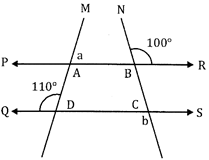
A)
\[225{}^\circ \] done
clear
B)
\[90{}^\circ \] done
clear
C)
\[180{}^\circ \] done
clear
D)
\[170{}^\circ \] done
clear
View Solution play_arrow
-
question_answer64)
In the given figure, line AB || line CD, \[m\angle ABFD={{45}^{\text{o}}}\]and \[m\angle CFD={{110}^{\text{o}}}\] then find \[m\,\angle FDC\]
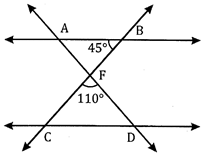
A)
\[45{}^\circ \] done
clear
B)
\[25{}^\circ \] done
clear
C)
\[35{}^\circ \] done
clear
D)
\[30{}^\circ \] done
clear
View Solution play_arrow
-
question_answer65)
The interior angle of regular polygon exceeds its exterior angle by\[60{}^\circ \]. The name of this polygon is?
A)
pentagon done
clear
B)
hexagon done
clear
C)
decagon done
clear
D)
octagon done
clear
View Solution play_arrow
-
question_answer66)
Given below the steps of construction bisection of a line segment in incorrect order. Read them carefully and choose the correct order. Step I: With centre A and radius more than half of AB, draw arcs, one on each side of AB. Step - II: Draw a line segment AB of given length. Step -III: Join EF intersecting AB at M. Then M bisects the line segment AB. Step - IV: With B as centre and the same radius as before, draw arcs, cutting the previously drawn arcs at E and F respectively.
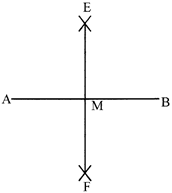
A)
II, I, III, IV done
clear
B)
II, I, IV, III done
clear
C)
I, II, IV, III done
clear
D)
I, II, III, IV done
clear
View Solution play_arrow
-
question_answer67)
ABCD is a quadrilateral. AB = BC = CD = DA and \[-DA=-DB=-DC=-DD={{90}^{\text{o}}}\]. Then ABCD can be called ________.
A)
square done
clear
B)
trapezium done
clear
C)
Kite done
clear
D)
rectangle done
clear
View Solution play_arrow
-
question_answer68)
ABCD is a parallelogram in which \[-D\,\,DAB={{75}^{\text{o}}}\] and \[-D\,DBC={{60}^{\text{o}}}\] then \[-DCDB=\]???.
A)
\[60{}^\circ \] done
clear
B)
\[75{}^\circ \] done
clear
C)
\[45{}^\circ \] done
clear
D)
\[135{}^\circ \] done
clear
View Solution play_arrow
-
question_answer69)
Which of the following statements is incorrect:
A)
Every parallelogram is a quadrilateral done
clear
B)
Every rectangle is a parallelogram done
clear
C)
Every rhombus is a parallelogram done
clear
D)
Every trapezium is a parallelogram done
clear
View Solution play_arrow
-
question_answer70)
DIRECTIONS: Match Column-I with Column-II and select the correct answer using the codes given below the columns.

A)
\[A\to (iv),\,B\to (iii);\,C\to (ii);\,D\to (i)\] done
clear
B)
\[A\to (iv),\,B\to (ii);\,C\to (iii);\,D\to (i)\] done
clear
C)
\[A\to (ii),\,B\to (iii);\,C\to (i);\,D\to (iv)\] done
clear
D)
\[A\to (ii),\,B\to (iii);\,C\to (i);\,D\to (iv)\] done
clear
View Solution play_arrow
-
question_answer71)
DIRECTIONS: Read the passage(s) given below and answer the questions that follow. Passage-1 In our everyday life, we see pictures, leaves of plants, wings of butterflies, blades, etc. All these objects have a property that one half of the object is exactly same in size and shape as the other half. Such objects are called symmetric objects. Thus, A figure is said to be symmetric if on being folded along a line, one part coincides with the other. The line of fold is called the line of symmetry.

Which type of line of symmetry divides letter A into two equal halves?
A)
Vertical line symmetry done
clear
B)
horizontal line symmetry done
clear
C)
Both vertical and horizontal done
clear
D)
Neither vertical nor horizontal done
clear
View Solution play_arrow
-
question_answer72)
DIRECTIONS: Read the passage(s) given below and answer the questions that follow. Passage-1 In our everyday life, we see pictures, leaves of plants, wings of butterflies, blades, etc. All these objects have a property that one half of the object is exactly same in size and shape as the other half. Such objects are called symmetric objects. Thus, A figure is said to be symmetric if on being folded along a line, one part coincides with the other. The line of fold is called the line of symmetry.

Which of the following figure has dotted line as line of symmetry?
A)
B)
C)
D)
View Solution play_arrow
-
question_answer73)
DIRECTIONS: Read the passage(s) given below and answer the questions that follow. Passage-1 In our everyday life, we see pictures, leaves of plants, wings of butterflies, blades, etc. All these objects have a property that one half of the object is exactly same in size and shape as the other half. Such objects are called symmetric objects. Thus, A figure is said to be symmetric if on being folded along a line, one part coincides with the other. The line of fold is called the line of symmetry.

Which of the following figure has only two lines of symmetry?
A)
A scalene triangle done
clear
B)
An isosceles triangle done
clear
C)
A rectangle done
clear
D)
An equilateral triangle done
clear
View Solution play_arrow
-
question_answer74)
DIRECTIONS: Read the passage(s) given below and answer the questions that follow. Passage-1 In our everyday life, we see pictures, leaves of plants, wings of butterflies, blades, etc. All these objects have a property that one half of the object is exactly same in size and shape as the other half. Such objects are called symmetric objects. Thus, A figure is said to be symmetric if on being folded along a line, one part coincides with the other. The line of fold is called the line of symmetry.

Which of the following figure has no line of symmetry?
A)
B)
C)
D)
None of these done
clear
View Solution play_arrow
-
question_answer75)
DIRECTIONS: Following questions consist of two statements, one labelled as the 'Assertion? and the other as 'Reason (R)? You are to examine these two statements carefully and select the answer to these items using the code given below. Assertion (A): In an equilateral triangle, if one angle equals 60°, then rest of the two are 150° each. Reason (R): In an equilateral triangle, all three angles are equal.
A)
Both A and R are individually true and R is the correct explanation of A: done
clear
B)
Both A and R are individually true but R is not the correct explanation of A. done
clear
C)
A is true but R is false done
clear
D)
A is false but R is true. done
clear
View Solution play_arrow
-
question_answer76)
DIRECTIONS: Following questions consist of two statements, one labelled as the 'Assertion? and the other as 'Reason (R)? You are to examine these two statements carefully and select the answer to these items using the code given below. Assertion (A): In a triangle D ABC, if \[\angle B={{90}^{\text{o}}},\] then it is a right angled triangle. Reason(R): If any one of the angles of a triangle is right angle, then it is a right angled triangle.
A)
Both A and R are individually true and R is the correct explanation of A: done
clear
B)
Both A and R are individually true but R is not the correct explanation of A. done
clear
C)
A is true but R is false done
clear
D)
A is false but R is true. done
clear
View Solution play_arrow
-
question_answer77)
DIRECTIONS: Following questions consist of two statements, one labelled as the 'Assertion? and the other as 'Reason (R)? You are to examine these two statements carefully and select the answer to these items using the code given below. Assertion (A): If radius of a circle is 5 cm, then its diameter is 10cm. Reason(R): A part of a circumference is called an arc.
A)
Both A and R are individually true and R is the correct explanation of A: done
clear
B)
Both A and R are individually true but R is not the correct explanation of A. done
clear
C)
A is true but R is false done
clear
D)
A is false but R is true. done
clear
View Solution play_arrow
-
question_answer78)
Read the following statements and which one is true? (i) A parallelogram in which two adjacent angles are equal is a rectangle. (ii) A quadrilateral in which both pairs of opposite angles are equal is parallelogram. (iii) In a parallelogram the number of acute angles is zero (or) two
A)
only (i) done
clear
B)
only (ii) done
clear
C)
only (iii) done
clear
D)
All (i), (ii) and (iii) done
clear
View Solution play_arrow
-
question_answer79)
Consider the following statements: (1) The diagonals of a parallelogram are equal (2) The diagonals of a rectangle are perpendicular to each other (3) If the diagonals of a quadrilateral intersect at right angles, it is not necessarily a rhombus. (4) Every quadrilateral is either a trapezium or a parallelogram or a kite. Which of the following statements is/are correct?
A)
only 2 done
clear
B)
only 3 done
clear
C)
both 2 & 3 done
clear
D)
All of them done
clear
View Solution play_arrow
-
question_answer80)
Which of the following statements is/are correct? (1) The diagonals of a rectangle are perpendicular. (2) The diagonals of a rhombus are equal. (3) Every square is a rhombus. (4) None of these
A)
only 1 done
clear
B)
only 3 done
clear
C)
1 and 2 done
clear
D)
all 1, 2, and 3 done
clear
View Solution play_arrow
-
question_answer81)
Read the information about the given figure and choose the false statement.
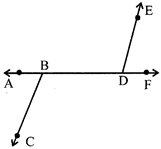
\[''\angle ABC={{30}^{\text{o}}},\,\angle EDF=(40-{{x}^{\text{o}}})\] and \[\angle ADE=13x+{{20}^{\text{o}}}''\].
A)
\[\angle ABC=\angle EDF\] done
clear
B)
\[\angle DBC\,+\angle EDF={{180}^{\text{o}}}\] done
clear
C)
\[BC||DE\] done
clear
D)
\[\angle BDE\] and \[\angle DBC\] are supplementary angles. done
clear
View Solution play_arrow
-
question_answer82)
Given below is a figure of folded sheet and design drawn about the fold. Which of the following will be a rough diagram of the complete figure that would be seen when the design is cut off.

A)
B)
C)
D)
View Solution play_arrow
-
question_answer83)
Which of the following figure has 4 lines of symmetry?
A)
B)
C)
D)
View Solution play_arrow
-
question_answer84)
How many angles are there in the given figure?
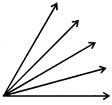
A)
8 done
clear
B)
9 done
clear
C)
10 done
clear
D)
11 done
clear
View Solution play_arrow
-
question_answer85)
What will be the angle between the hour hand and the minute hand at half past four?
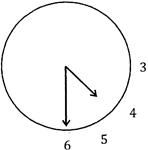
A)
\[{{45}^{\text{o}}}\] done
clear
B)
\[30{}^\circ \] done
clear
C)
\[90{}^\circ \] done
clear
D)
\[75{}^\circ \] done
clear
View Solution play_arrow
-
question_answer86)
The road parallel to Rafi Ahmed Kidwai Marg and perpendicular to Raj-path is
A)
Shahstri Bhwan done
clear
B)
Janpath done
clear
C)
Akbar Road done
clear
D)
KamraJ Road done
clear
View Solution play_arrow
-
question_answer87)
The point of intersection of Kasturba Gandhi Marg and Tilak Marg is
A)
Shahjahan road done
clear
B)
Akbar Road done
clear
C)
India Gate done
clear
D)
Raj Path done
clear
View Solution play_arrow
-
question_answer88)
The road intersecting Talkatora Road and parallel to Mandir marg is
A)
Sansad Marg done
clear
B)
Peshwa Road done
clear
C)
Rafi Marg done
clear
D)
None of these done
clear
View Solution play_arrow
-
question_answer89)
The road between Raja Bazar square and the Telegraph Place is
A)
Peshwa Road done
clear
B)
Connaught Place done
clear
C)
Baba Kharak Singh Marg done
clear
D)
Shaheed Bhagat Singh Marg done
clear
View Solution play_arrow


![]()




 Find the value of angle y in the above figure.
Find the value of angle y in the above figure. 

 done
clear
done
clear
 done
clear
done
clear
 done
clear
done
clear
 done
clear
done
clear
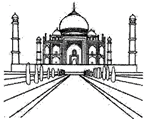 done
clear
done
clear
 done
clear
done
clear
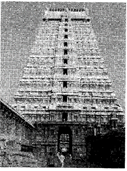 done
clear
done
clear
 done
clear
done
clear
 done
clear
done
clear
 done
clear
done
clear
 done
clear
done
clear
 done
clear
done
clear

